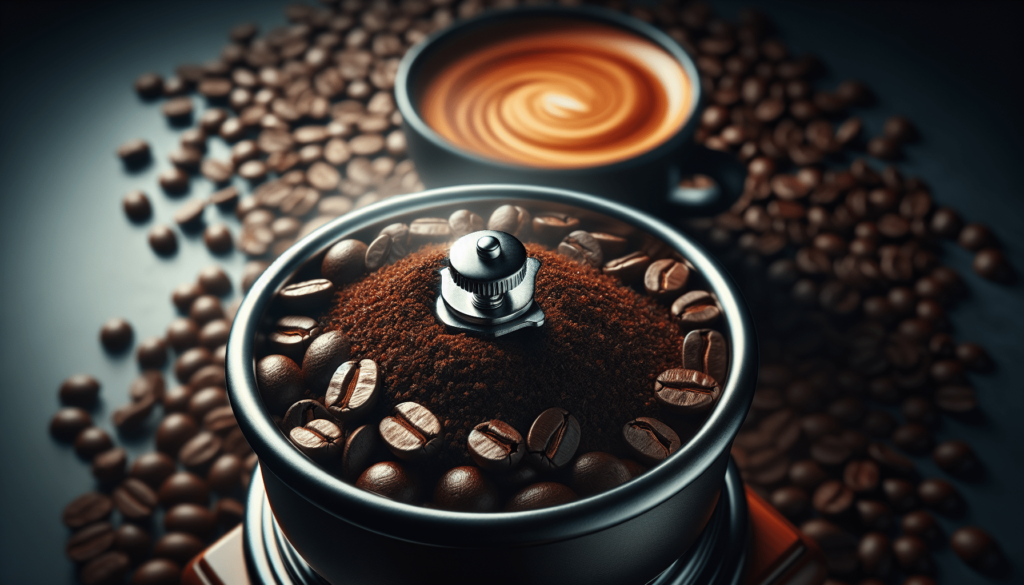If you’re a coffee lover on a mission to brew the perfect espresso at home, finding the right coffee grinder is essential. The quest to achieve that rich, flavorful shot of espresso can be daunting, but fear not! In this article, we’ll explore the world of coffee grinders and help you discover the best one for grinding that perfect espresso grind. Say goodbye to inconsistent grounds and hello to delicious espresso that will rival your favorite café. Let’s dive into the wonderful world of coffee grinders!

Burr Grinders
Why choose a burr grinder for espresso?
When it comes to brewing espresso, consistency is key. And that’s where burr grinders shine. Unlike blade grinders, which chop the coffee beans unevenly, burr grinders crush the beans between two revolving abrasive surfaces, resulting in a consistent grind size. This uniformity is crucial for espresso, as it ensures an even extraction and optimal flavor profile in every shot.
How does a burr grinder work?
A burr grinder consists of two burrs, typically made of ceramic or stainless steel, that rotate against each other. The gap between these burrs can be adjusted to control the grind size. As the coffee beans enter the grinder, they are crushed into smaller particles between the burrs. The size of the particles is determined by the distance between the burrs, which can be customized based on the desired grind size.
Benefits of using a burr grinder for espresso
Using a burr grinder for espresso offers several advantages. Firstly, the consistent grind size ensures a more even extraction, resulting in a balanced and flavorful shot of espresso. Additionally, burr grinders allow for more precise adjustments, allowing you to dial in the perfect grind size for your preferred brewing method. Lastly, burr grinders tend to produce less heat during the grinding process, reducing the risk of overheating the coffee and preserving its delicate flavors.
Top recommended burr grinders for espresso
- Baratza Sette 270: Known for its exceptional grind consistency and speed, the Baratza Sette 270 is a top choice among espresso enthusiasts.
- Rancilio Rocky: With its durable build and precise grind settings, the Rancilio Rocky is a popular option for home espresso setups.
- Breville Smart Grinder Pro: Offering a wide range of grind settings and advanced features like a timed dosing system, the Breville Smart Grinder Pro is a versatile option for espresso lovers.
Blade Grinders
Why choose a blade grinder for espresso?
While burr grinders are often preferred for espresso, blade grinders still have their place. One advantage of blade grinders is their affordability, making them a budget-friendly option for those just starting their espresso journey. Additionally, blade grinders are compact and easy to use, making them a convenient choice for those with limited counter space or who prefer simplicity.
How does a blade grinder work?
Blade grinders operate by using sharp blades to chop the coffee beans into smaller particles. Unlike burr grinders, blade grinders do not offer as much control over the grind size and can often result in an inconsistent grind. The longer the grinder is operated, the smaller the particles become. However, due to the lack of uniformity, achieving the perfect grind size for espresso can be challenging with a blade grinder.
Pros and cons of using a blade grinder for espresso
While blade grinders are more affordable and easy to use, they come with some drawbacks. The lack of grind consistency can lead to uneven extraction, resulting in an imbalanced or bitter espresso. Additionally, blade grinders tend to generate more heat during the grinding process, which can potentially affect the flavor of the coffee. However, for those on a tight budget or looking for a simple brewing solution, a blade grinder can still produce a decent cup of espresso.
Top recommended blade grinders for espresso
- Krups F203: An affordable and compact option, the Krups F203 is a popular choice for beginners or those looking for a budget-friendly grinder.
- Cuisinart DBM-8: With its sleek design and stainless steel blades, the Cuisinart DBM-8 offers consistent results at an affordable price point.
- KitchenAid Blade Coffee Grinder: Known for its durability and user-friendly design, the KitchenAid Blade Coffee Grinder is a reliable choice for espresso enthusiasts on a budget.
Grind Size and Consistency
Importance of grind size and consistency for espresso
In the world of espresso, grind size and consistency play a crucial role in the final cup. The size of the coffee particles determines the rate at which water can extract flavor from the coffee grounds. Too fine of a grind can result in over-extraction, leading to a bitter taste, while too coarse of a grind can result in under-extraction, resulting in a weak and sour shot. Consistency in grind size ensures an even extraction, allowing for a balanced and flavorful espresso.
Factors influencing grind size and consistency
Several factors can influence the grind size and consistency, including the type of coffee grinder used, the brewing method, and the type of beans being used. Burr grinders are known for their ability to provide a more consistent grind size due to the precise adjustment settings. On the other hand, blade grinders may produce a wider range of particle sizes, making it more challenging to achieve the ideal grind for espresso.
How to achieve the correct grind size and consistency for espresso
To achieve the correct grind size and consistency for espresso, it is crucial to invest in a high-quality burr grinder. Start by adjusting the grinder to a finer grind size and test the extraction. If the espresso shot is overly bitter or has a slow flow, adjust the grind size slightly coarser. Conversely, if the shot is weak or has a fast flow, adjust the grind size slightly finer. It may take some trial and error to find the perfect grind size, but with patience and experimentation, you can dial in the ideal parameters for your espresso.
Adjustability
Why is adjustability important in a coffee grinder for espresso?
Adjustability is vital in a coffee grinder for espresso because it allows you to fine-tune the grind size to achieve the optimal extraction for your brewing method. Different coffee beans, roast levels, and humidity levels require adjustments in the grind size to maintain consistency and quality in the espresso. The ability to easily adjust the grind size ensures that you can adapt to the specific characteristics of each batch of coffee, resulting in a more precise and flavorful shot.
Different levels of adjustability in espresso grinders
Espresso grinders offer varying levels of adjustability, ranging from stepped adjustments to stepless adjustments. Stepped adjustments have pre-set grind size options, allowing you to easily switch between different settings. Stepless adjustments, on the other hand, provide infinite grind size options, giving you ultimate control over the grind size. While stepped adjustments are generally more user-friendly, stepless adjustments offer greater precision for fine-tuning the grind size.
Recommended espresso grinders with high adjustability
- Eureka Mignon Specialita: This grinder offers stepless adjustments, allowing for precise control over the grind size. It also features a digital display for easy and accurate adjustments.
- Baratza Vario-W: With its macro and micro adjustment settings, the Baratza Vario-W provides both convenience and precision in achieving the perfect grind size.
- Mazzer Mini Electronic Type A: Known for its commercial-grade quality, this grinder offers stepless adjustments and electronic dosing, making it a favorite among espresso enthusiasts.

Durability and Build Quality
Why is durability important in a coffee grinder for espresso?
Durability is crucial in a coffee grinder for espresso because it ensures the longevity and reliability of the machine. Espresso grinders undergo rigorous use, with intense grinding and frequent adjustments. Investing in a durable grinder guarantees that it can withstand the demands of daily espresso brewing and maintain consistent performance over time.
Materials and construction of espresso grinders
Espresso grinders are typically constructed using high-quality materials such as stainless steel, aluminum, and durable plastics. Stainless steel is commonly used for burrs, as it provides excellent grind consistency and longevity. Aluminum is often used for the grinder body due to its lightweight yet sturdy nature. Quality plastics are used for various components, ensuring durability without compromising performance.
Highly durable espresso grinders
- Mazzer Super Jolly: Built with a heavy-duty body and commercial-grade components, the Mazzer Super Jolly is known for its robustness and longevity.
- Compak E10 Master Conic PB: Made with high-quality materials and precision engineering, the Compak E10 Master Conic PB offers exceptional durability for professional-grade espresso grinding.
- Mahlkönig K30 Vario Air: Designed for heavy-duty use, the Mahlkönig K30 Vario Air features a solid build and reliable performance, making it a long-lasting investment for espresso enthusiasts.
Grinding Speed
Impact of grinding speed on espresso quality
The grinding speed of an espresso grinder can have a significant impact on the overall quality of the espresso. Slow grinding speeds are generally preferred, as they generate less heat and minimize the risk of damaging the coffee beans or affecting their flavor. Additionally, slower grinding allows for a more consistent grind size and extraction, resulting in a more balanced and flavorful shot of espresso.
Factors influencing grinding speed
Several factors influence the grinding speed of an espresso grinder. The type of grinder (burr or blade), motor power, and design all play a role in determining the speed at which the coffee beans are ground. Burr grinders tend to have slower grinding speeds but offer more consistency. Blade grinders, on the other hand, tend to operate at higher speeds, which can result in increased heat and inconsistent particle sizes.
Espresso grinders with optimal grinding speed
- Baratza Forté AP: Known for its low-speed grinding and consistent results, the Baratza Forté AP ensures a high-quality and precise espresso extraction.
- Eureka Atom: Designed with a powerful motor and slow grinding speed, the Eureka Atom maintains a cool temperature during the grinding process, preserving the delicate flavors of the coffee.
- Profitec Pro T64: This grinder features a unique burr design, resulting in slower grinding speeds and reduced heat generation, allowing for a superior espresso extraction.
Ease of Use and Cleaning
Why is ease of use and cleaning important in an espresso grinder?
Ease of use and cleaning are essential factors to consider when choosing an espresso grinder. As a coffee enthusiast, you want a grinder that can effortlessly integrate into your daily routine without causing unnecessary hassle. Furthermore, easy cleaning ensures the removal of any residual coffee oils or grounds, preventing flavor contamination and maintaining the performance of the machine.
Features that contribute to ease of use and cleaning
Various features contribute to the ease of use and cleaning of an espresso grinder. Some grinders offer intuitive control panels or digital displays, allowing for quick and precise adjustments. Removable components, such as the bean hopper and grind chamber, make cleaning more convenient. Additionally, grinders with built-in cleaning mechanisms or self-cleaning options simplify maintenance and ensure consistent performance over time.
User-friendly espresso grinders with easy cleaning
- Breville Smart Grinder Pro: This grinder features a user-friendly interface, allowing for easy adjustment of grind settings. The removable burrs and hopper make cleaning a breeze.
- Baratza Encore: Known for its simplicity and straightforward design, the Baratza Encore offers easy operation and cleaning for beginners and experienced coffee enthusiasts alike.
- Rancilio Silvia Rocky SD: Designed with user-friendliness in mind, this grinder has easily accessible adjustment knobs and detachable components, making it effortless to clean and maintain.
Price Range
The impact of price on espresso grinder quality
Price often correlates with the quality of an espresso grinder. Higher-priced grinders generally offer better build quality, more precise grind settings, and advanced features that contribute to a superior espresso experience. However, it is still possible to find affordable options that provide satisfactory performance, especially for casual home use. Ultimately, the price range that you choose should align with your brewing preferences and budget.
Different price ranges for espresso grinders
Espresso grinders are available in a wide range of prices, catering to different budgets and needs. Entry-level grinders typically range from $50 to $200, offering basic functionality and grind consistency. Mid-range grinders can range from $200 to $500, providing more robust construction, advanced features, and enhanced grind settings. High-end grinders, priced at $500 or above, often boast professional-grade build quality, precision engineering, and exceptional grind consistency.
Top espresso grinders in each price range
- Entry-level: Baratza Encore
- Mid-range: Eureka Mignon Specialita
- High-end: Mazzer Mini Electronic Type A
Electric vs Manual Grinders
Pros and cons of electric espresso grinders
Electric espresso grinders offer convenience and efficiency. With the push of a button, you can easily grind the desired amount of coffee with minimal effort and time. Electric grinders also provide precise control over the grind size, allowing for consistent results. However, they can be more expensive and require a power source, making them less portable than manual grinders.
Pros and cons of manual espresso grinders
Manual espresso grinders operate without the need for electricity, making them portable and suitable for travel or outdoor use. They also offer a hands-on experience, allowing you to connect with the coffee preparation process. Manual grinders are often more affordable than their electric counterparts, but they require more effort and time to grind the coffee manually. Additionally, achieving consistent grind sizes can be more challenging with manual grinders.
Which type of grinder is better for espresso?
The choice between electric and manual grinders ultimately depends on personal preference and brewing habits. Electric grinders are better suited for those seeking convenience, speed, and precise control over the grind size. If you are primarily using the grinder at home or in a coffee shop setting, an electric grinder is likely the more practical choice. However, if you value portability, enjoy a hands-on approach to brewing, or frequently travel, a manual grinder can be a great option.
Customer Reviews and Recommendations
Importance of customer reviews and recommendations
Customer reviews and recommendations provide valuable insights and firsthand experiences with specific espresso grinders. They offer an unbiased perspective on the performance, durability, and overall user experience of the grinder. Reading reviews can help you gauge the reliability and consistency of a grinder, allowing you to make an informed decision based on real-world experiences.
Notable espresso grinders preferred by customers
- Baratza Sette 270: Praised for its consistent grind quality and user-friendly interface, the Baratza Sette 270 is often recommended by espresso enthusiasts.
- Rancilio Rocky: Loved for its durability and ability to deliver a consistent grind, the Rancilio Rocky garners positive reviews from coffee enthusiasts around the world.
- Mazzer Super Jolly: Highly regarded for its commercial-grade build quality and reliability, the Mazzer Super Jolly is a favorite among professional baristas and home users alike.
Factors to consider when reading customer reviews
When reading customer reviews, it is essential to consider a few key factors. Look for reviews that mention the specific features or characteristics you prioritize in an espresso grinder, such as grind consistency, durability, ease of use, or customer support. Pay attention to reviews from customers who have similar brewing preferences, as their experiences may align more closely with your own. It is also beneficial to read a variety of reviews to gain a well-rounded understanding of the grinder’s strengths and potential limitations.

